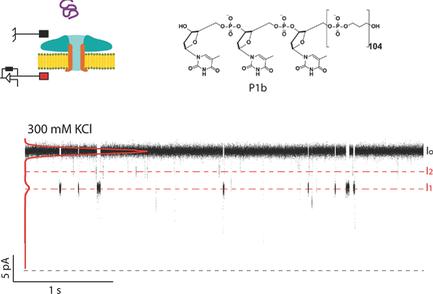当前位置:
X-MOL 学术
›
Macromol. Rapid Commun.
›
论文详情
Our official English website, www.x-mol.net, welcomes your
feedback! (Note: you will need to create a separate account there.)
Translocation of Precision Polymers through Biological Nanopores
Macromolecular Rapid Communications ( IF 4.2 ) Pub Date : 2017-11-16 , DOI: 10.1002/marc.201700680 Mordjane Boukhet 1 , Niklas Felix König 2 , Abdelaziz Al Ouahabi 2 , Gerhard Baaken 1 , Jean-François Lutz 2 , Jan C. Behrends 3, 4, 5
Macromolecular Rapid Communications ( IF 4.2 ) Pub Date : 2017-11-16 , DOI: 10.1002/marc.201700680 Mordjane Boukhet 1 , Niklas Felix König 2 , Abdelaziz Al Ouahabi 2 , Gerhard Baaken 1 , Jean-François Lutz 2 , Jan C. Behrends 3, 4, 5
Affiliation

|
Nanopore analysis, which is, currently, chiefly used for DNA sequencing, is also an appealing technique for characterizing abiotic polymers. As a first step toward this goal, nanopore detection of non‐natural monodispersed poly(phosphodiester)s as candidate backbone structures is reported herein. Two model homopolymers containing phosphopropyl repeat units (i.e., 56 or 104 r.u.) and a short thymidine nucleotide sequence are analyzed in the present work. They are tested in two different biological nanopores, α‐hemolysin from Staphylococcus aureus, and aerolysin from Aeromonas hydrophila. These recordings are performed in aqueous medium at different KCl concentrations and various driving voltages. The data show a complex interaction with evidence for voltage dependence and threading, and underline the influence of the molecular structure and orientation of the precision poly(phosphodiester)s on the observed residual current signal as well as on the translocation dynamics. In particular, they suggest a dominant entropic contribution due to the high flexibility of the phosphodiester homopolymer.
中文翻译:

精密聚合物通过生物纳米孔的移位
目前主要用于DNA测序的纳米孔分析也是一种用于表征非生物聚合物的诱人技术。作为朝着这个目标迈出的第一步,本文报道了非天然单分散聚(磷酸二酯)作为候选主链结构的纳米孔检测。在本工作中,分析了两种含有磷丙基重复单元(即56或104 ru)和较短的胸苷核苷酸序列的模型均聚物。它们在两种不同的生物纳米孔中进行了测试,分别是金黄色葡萄球菌的α-溶血素和亲水性嗜水气单胞菌的溶血素。。这些记录是在水性介质中以不同的KCl浓度和各种驱动电压进行的。数据显示出与电压依赖性和穿线证据复杂的相互作用,并强调了精密聚磷酸二酯的分子结构和取向对观察到的残余电流信号以及易位动力学的影响。特别地,由于磷酸二酯均聚物的高柔韧性,它们表明了主要的熵贡献。
更新日期:2017-11-16
中文翻译:

精密聚合物通过生物纳米孔的移位
目前主要用于DNA测序的纳米孔分析也是一种用于表征非生物聚合物的诱人技术。作为朝着这个目标迈出的第一步,本文报道了非天然单分散聚(磷酸二酯)作为候选主链结构的纳米孔检测。在本工作中,分析了两种含有磷丙基重复单元(即56或104 ru)和较短的胸苷核苷酸序列的模型均聚物。它们在两种不同的生物纳米孔中进行了测试,分别是金黄色葡萄球菌的α-溶血素和亲水性嗜水气单胞菌的溶血素。。这些记录是在水性介质中以不同的KCl浓度和各种驱动电压进行的。数据显示出与电压依赖性和穿线证据复杂的相互作用,并强调了精密聚磷酸二酯的分子结构和取向对观察到的残余电流信号以及易位动力学的影响。特别地,由于磷酸二酯均聚物的高柔韧性,它们表明了主要的熵贡献。











































 京公网安备 11010802027423号
京公网安备 11010802027423号